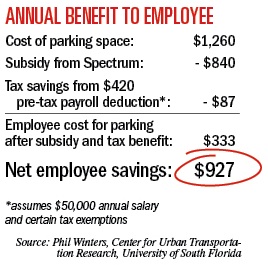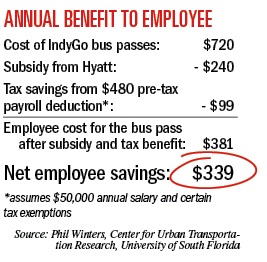Subscriber Benefit
As a subscriber you can listen to articles at work, in the car, or while you work out. Subscribe NowWhen Bloomington resident Jelanna Morgan landed a job in downtown Indianapolis in July 2011, she faced a costly commuting conundrum. And the pocketbook-friendly solution—believe it or not—came in part via the Internal Revenue Service.
One option was to drive her gas-guzzling 2005 Lincoln Navigator every day to her new gig as an IT strategy consultant at KPMG, racking up a 120-mile round trip. But a friend suggested Morgan try to hook up with a group that commuted from Bloomington to Indy via van.
A couple of drawbacks: They left town at 5:50 a.m., and leg room in the 12-seat vehicle was a little tight.
No matter. Today, Morgan works on her laptop and corresponds with colleagues
in Asia as the van makes the trek into Indianapolis. Sure, it’s the green and gas-saving thing to do. Morgan believes she could be avoiding as much as $400 in commute-by-car costs per month.
But, thanks to commuting benefits made possible by the IRS, even more money can be recouped.
Through a program that reduces the cost of commuting for its employees, KPMG allows Morgan to make a monthly $125 pre-tax payroll deduction to pay for her share of the vanpool. Subtract that $1,500 per year from her taxable income, and she pockets another $310 from her paycheck.
“You can’t argue with those numbers,” Morgan said from her office in Chase Tower.
The benefits don’t end there. Due to Morgan’s $1,500 reduction in taxable income, KPMG doesn’t have to pay Federal Insurance Contributions Act payroll tax (which covers its Social Security and Medicare contributions) on that amount. So KPMG saves about $115.
Hard to argue with, indeed. But it’s a bit tough to explain.
In a dark little corner of the tax code known as Section 132(f), the IRS lets employers provide tax-free benefits—typically, payroll deductions and/or subsidies—to employees for commuting costs. That includes vans, buses, bikes, trains, and even parking. And both parties can save, since they’re not getting dinged for their respective taxes on the amount of the benefit.
Andrew McGee preaches this wallet-friendly gospel as manager of Commuter Connect, a program operating under the auspices of the Central Indiana Regional Transportation Authority.
“It’s a win-win,” McGee said. “It’s lowering taxable income on both sides.”
Commuter Connect encourages Indianapolis-area workers and employers to get on the alternative-transportation bandwagon and take better advantage of commuting options like carpooling, vanpooling, riding the bus and biking. That includes helping business owners understand how they can offer commuting benefits to employees, how the tax advantages work, and how it all can improve their businesses.
“It comes back to offering an additional benefit to your workers and being an employer of choice,” McGee said.
For example, offering the benefits can be a big advantage for businesses in the same industry where the pay range is similar among competitors.
It should be said that Commuter Connect doesn’t actively promote parking benefits, which tend to reward employees for driving to work. But the group does try to convince companies that already offer parking benefits to branch into public transit and vanpooling, as well.
“I think a lot of people aren’t aware that they can do it for transit and vanpooling, so for us it’s educating them,” McGee said. “For others, it’s a fear, depending on their location, that they’ll offer it and it won’t be used much.”
The parking tax break has been available to employers for several decades. The ever-shifting tax code has included benefits for greener commuting options like vanpooling and public transit for about 20 years.
One conspicuous absence from the roster of benefit-worthy options is carpooling. When the code instituted these greener modes of transportation, carpooling was considered too informal an arrangement with little or no paper trail for tracking expenses, said Jason Pavluchuk, legislative associate with the Washington, D.C.-based Association for Commuter Transportation.
(Tax code trivia: Vanpooling is different from carpooling, in that the vehicle must have seating capacity for at least seven adults, with at least four on board during commutes, and that travel to and from work must account for at least 80 percent of the vehicle’s mileage. Vans typically are provided by an outside vendor, making expenses and mileage easier to document.)
Still, no more than 6 percent of U.S. employees had access to tax benefits for these alternative-transportation options in 2011, according to the Bureau of Labor Statistics.
That squares with McGee’s experience.
More than 400 central Indiana employers participate in Commuter Connect’s services, McGee said. Of those, only about 50 offer their workers subsidies or pre-tax benefits related to public transportation or vanpooling.
One of those is the Hyatt Regency Indianapolis, which subsidizes $20 of IndyGo’s $60 monthly bus pass for its employees. They can cover the remaining $40 with a pre-tax payroll deduction.
Typically, 30 to 40 of the hotel’s 200-plus employees take advantage of the discounted passes each month, according to Brian Lockner, director of human resources.
 Tina McElroy takes advantage of tax benefits to lower the cost of parking downtown. (IBJ Photo/ Perry Reichanadter)
Tina McElroy takes advantage of tax benefits to lower the cost of parking downtown. (IBJ Photo/ Perry Reichanadter)Beyond appreciation from Hyatt employees, Lockner believes the program also can improve job performance by providing regular and reliable transportation.
“If your associates aren’t worried about getting to and from work, they can spend more time focusing on guests,” he said. “It helps them get to work safely. It helps keep them productive.”
Indiana University Health also allows pre-tax payroll deductions for public transit passes, as well as for parking expenses.
“IU Health is trying to do what we can from a work-life quality standpoint,” said Robert Flood, supervisor of benefit plans for IU Health. “We work our employees hard, and we try to give them some support wherever we can.”
Throughout the IU Health system statewide, about 3,700 employees take advantage of the parking option, according to Flood. That reduces their collective taxable income about $107,000 per month, which amounts to about $6,000 per month in savings on payroll taxes for IU Health.
IU Health’s benefit for bus passes is available only to employees in the Indianapolis area, who typically take either IndyGo or the Indy Express service between Hamilton County and downtown. The 52 employees using the benefit reduce their collective taxable income about $3,100 per month, leading to $175 in savings in payroll taxes for the hospital system.
Flood believes the system’s tax savings essentially pay for the in-house administration of the benefits.
“It’s not like we’re making money, but it’s not costing us anything, either,” he said. “We feel it’s a wash, whatever the costs are.”
Cost questions
Flood touched on one of the biggest perceived barriers to instituting or expanding a commuting benefits program: cost.
Some employers, like IU Health, handle their programs in-house, while others rely on third-party benefit administration firms to take care of the chore. Either way, they often see starting or bolstering a program as an unwanted expense.
“Some of the third-party providers will charge for each piece that employers will want, even when they already have the parking aspect in place,” McGee said. “Or an employer will look at it like, ‘We’re going to have to add more work time or responsibility for someone in the payroll department.’”
Potential time spent wrestling with the intricacies of the tax code may be the reason the bicycle commuting benefit is so rarely used.
Section 132(f) allows employers to reimburse their bicycle commuters up to $20 per month for “reasonable expenses” incurred by the employee during the calendar year. But some employers complain that the language is vague. Confusing areas include the kinds of items that can be reimbursed, and the period over which expenses are eligible.
“I think people recognize that it isn’t ideal,” said Phil Winters, director of the Traffic Demand Management Program at the Center for Urban Transportation Research at the University of South Florida. “Most employers I talk with just don’t want to mess with it.”
McGee wasn’t aware of any Indianapolis-area employers offering the biking benefit. Another drawback, he said, was that while public transit and vanpool commuters can pair their benefits with those for parking—say, driving your car to a park-and-ride lot, and then taking the bus to work—bicycle commuters are only allowed to seek the reimbursement.
However, commuter tax benefits as a whole provide a pretty good bang for employers’ bucks, Winters said.
“Ultimately, the beauty of it is that the employers can tailor it to their circumstances, to whatever makes sense for them,” he said.•
—————————————-
TINA McELROY
office manager, Spectrum Underwriting Managers Inc.
McElroy makes the daily 9-to-5 trek to work from Nora in her 2005 Honda CRV, and parks in a lot next to Spectrum’s offices at 41 E. Washington St. Her spot would cost $105 per month, but Spectrum takes advantage of commuter tax benefits for parking that significantly lower her expense.
 Spectrum subsidizes $70 of that monthly cost, then allows McElroy to pay the remaining $35 with a pre-tax payroll deduction. So, on an annual basis, Spectrum kicks in $840, and McElroy avoids paying payroll taxes on $420.
Spectrum subsidizes $70 of that monthly cost, then allows McElroy to pay the remaining $35 with a pre-tax payroll deduction. So, on an annual basis, Spectrum kicks in $840, and McElroy avoids paying payroll taxes on $420.
That works out to a significant savings for McElroy, likely in the neighborhood of $927. (See accompanying chart; this computation assumes a $50,000 salary—not McElroy’s actual pay—and certain tax exemptions.)
Spectrum also sees a bright side from its $840 subsidy. Its net cost likely ends up being less than $800, after deducting the subsidy as a business expense and factoring in savings from the decrease in McElroy ’s taxable income.
McElroy appreciates the big discount for parking.
“My husband used to work at the Chase Tower. He didn’t have this benefit, and he paid $135 per month for parking,” she said. “A lot of people who work in the suburbs have free parking. So it’s a great benefit for people who work downtown.”•
—————————————-
DEBBIE COLBERT
administrative assistant, Hyatt Regency Indianapolis
Colbert has worked at the Hyatt since it opened more than three decades ago, and has been taking public transportation to the downtown hotel for almost as long.
Starting from her home in the Broad Ripple area, she walks to a nearby stop to catch the No. 18 IndyGo bus at around 6 a.m. She rides downtown to a stop a block or two from the hotel at Washington Street and Capitol Avenue. She heads back uptown around 3:30 p.m.
 Every month, the hotel buys a few dozen $60 monthly bus passes from IndyGo and allows employees such as Colbert to purchase them with a tax-free payroll deduction of $40. The hotel covers the $20 balance, which commuter benefits tax laws count as a deduction for the Hyatt.
Every month, the hotel buys a few dozen $60 monthly bus passes from IndyGo and allows employees such as Colbert to purchase them with a tax-free payroll deduction of $40. The hotel covers the $20 balance, which commuter benefits tax laws count as a deduction for the Hyatt.
Colbert enjoys a number of things about the bus-pass program.
“It’s convenient,” she said. “I can pick up the pass from the human resources office. The cost is deducted out of my check. It’s cheaper than parking downtown, and I don’t have to pay for gas.”
And then there are the savings over the full cost of an IndyGo monthly pass, which would come out to $720 per year. Adding the $240 that the hotel kicks in annually to the savings on the pre-tax payroll deduction, Colbert likely saves in the neighborhood of $339. (See accompanying chart; this computation assumes a $50,000 salary—not Colbert’s actual pay—and certain tax exemptions.)
“It’s a significant savings,” Colbert said. “It’s a plus. It’s one of the benefits I’m happy to have.”
Hyatt also reaps benefits from its $240 subsidy. Its net cost likely ends up being less than $200, after deducting the subsidy as a business expense and factoring in savings from the decrease in Colbert’s taxable income.•
Please enable JavaScript to view this content.
